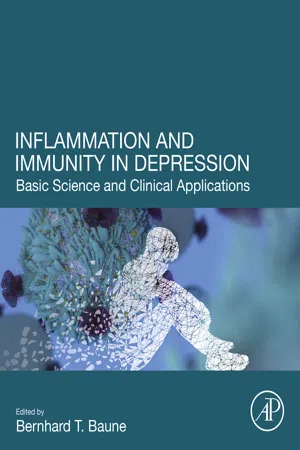
Inflammation and Immunity in Depression
Basic Science and Clinical Applications
- 636 pages
- English
- ePUB (mobile friendly)
- Available on iOS & Android
About This Book
Inflammation and Immunity in Depression: Basic Science and Clinical Applications is the first book to move beyond the established theory of cytokine-induced depression and explore the broader role the immune system plays in this devastating mood disorder. The book fully explores the most recent lines of research into this rapidly advancing field, including alterations of T-cells, the neurobiological implications of neuroinflammation and immune alterations for brain development and function, and the genetic components of neuroinflammation in depression, including the relationships between stress and inflammation that are revealing gene-environment interactions in the disorder.
Combining contributions from researchers worldwide, this book provides the most comprehensive discussion available today on the involvement of the innate immune and adaptive immune systems in depressive disorder. Chapters span neuroscience, psychology, clinical applications and future directions, making this book an invaluable resource for advanced students, researchers and practitioners who need to understand the complex and varied role of inflammation and immune responses in depression.
- Synthesizes current knowledge of inflammation and immunity in depression, ranging from basic neuroscience research, to clinical applications in psychiatry
- Expands on the long-established theory of cytokine-induced depression to discuss broader involvement of the immune system
- Explores translational potential of targeting immune dysfunction for clinical interventions
Frequently asked questions
Information
Depression-Associated Cellular Components of the Innate and Adaptive Immune System
Abstract
Keywords
The Innate Immune System

Role of Neutrophils in Innate Immunity and MDD
Monocytes and MDD
Table of contents
- Cover image
- Title page
- Table of Contents
- Copyright
- Contributors
- Preface
- Chapter 1: Depression-Associated Cellular Components of the Innate and Adaptive Immune System
- Chapter 2: Childhood Microbial Experience, Immunoregulation, Inflammation, and Adult Susceptibility to Psychosocial Stressors and Depression
- Chapter 3: Neuroendocrine Abnormalities in Major Depression: An Insight Into Glucocorticoids, Cytokines, and the Kynurenine Pathway
- Chapter 4: Neurovascular Dysfunction With BBB Hyperpermeability Related to the Pathophysiology of Major Depressive Disorder
- Chapter 5: The Impact of Inflammation on Brain Function and Behavior in Rodent Models of Affective Disorders
- Chapter 6: Neurogenesis, Inflammation, and Mental Health
- Chapter 7: The Roles of T Cells in Clinical Depression
- Chapter 8: Do Chemokines Have a Role in the Pathophysiology of Depression?
- Chapter 9: Inflammasomes Action as an Important Mechanism in Experimental and Clinical Depression
- Chapter 10: Pathways Driving Neuroprogression in Depression: The Role of Immune Activation
- Chapter 11: Gene Expression of Inflammation Markers in Depression
- Chapter 12: Neuroimmunopharmacology at the Interface of Inflammation and Pharmacology Relevant to Depression
- Chapter 13: The Gut-Brain-Microbe Interaction: Relevance in Inflammation and Depression
- Chapter 14: Childhood Trauma and Adulthood Immune Activation
- Chapter 15: Stress, Maltreatment, Inflammation, and Functional Brain Changes in Depression
- Chapter 16: Structural Neuroimaging of Maltreatment and Inflammation in Depression
- Chapter 17: Biological Embedding of Childhood Maltreatment in Adult Depression
- Chapter 18: Epigenetic Changes in the Immune Systems Following Early-Life Stress
- Chapter 19: Mechanisms Linking Depression, Immune System and Epigenetics During Aging
- Chapter 20: Role of Inflammation in Neuropsychiatric Comorbidity of Obesity: Experimental and Clinical Evidence
- Chapter 21: Inflammation and Depression in Patients With Autoimmune Disease, Diabetes, and Obesity
- Chapter 22: Does Inflammation Link Clinical Depression and Coronary Artery Disease?
- Chapter 23: Inflammation Genetics of Depression
- Chapter 24: Adolescent-Onset Depressive Disorders and Inflammation
- Chapter 25: Inflammation in Bipolar Disorder
- Chapter 26: Depression Subtypes and Inflammation: Atypical Rather Than Melancholic Depression Is Linked With Immunometabolic Dysregulations
- Chapter 27: Inflammation as a Marker of Clinical Response to Treatment: A Focus on Treatment-Resistant Depression
- Chapter 28: Clinical Trials of Anti-Inflammatory Treatments of Major Depression
- Chapter 29: Alcohol, Inflammation, and Depression: The Gut-Brain Axis
- Chapter 30: Efficacy of Anti-Inflammatory Treatment in Depression
- Chapter 31: Modulation of Inflammation by Antidepressants
- Chapter 32: The Biological Underpinnings of Mood Disorders Interact With Early Trauma, Sexual Abuse and Neuroticism: Implications for Psychiatric Classification and Treatment
- Chapter 33: Is There Still Hope for Treating Depression With Antiinflammatories?
- Chapter 34: Effects of Physical Exercise on Inflammation in Depression
- Chapter 35: Future Perspectives on Immune-Related Treatments
- Index